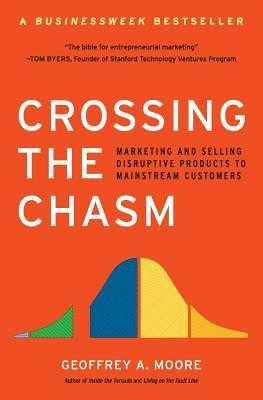Charlotte Hampton's Key Ideas from Crossing the Chasm: Marketing and Selling High-Tech Products to Mainstream Customers
by Geoffrey A. Moore
Ideas, facts & insights covering these topics:
9 ideas
·3.26K reads
24
1
Explore the World's Best Ideas
Join today and uncover 100+ curated journeys from 50+ topics. Unlock access to our mobile app with extensive features.
Product Positioning And Marketing: Crossing The Chasm
The point of greatest peril in the development of a high-tech market lies in making the transition from an early market dominated by a few visionary customers to a mainstream market dominated by a large block of customers who are predominantly pragmatists in orientation.
The gap between these two markets, heretofore ignored, is in fact so significant as to warrant being called a chasm, and crossing this chasm must be the primary focus of any long-term high-tech marketing plan. A successful crossing is how high-tech fortunes are made; failure in the attempt is how they are lost.
87
669 reads
The Tech Adoption Life Cycle
- The product is first used by innovators, people with keen interest in technology.
- Secondly, by the Early Adopters, who appreciate the benefits of the new concept.
- As the product gets traction and becomes mainstream, the early majority starts to use it.
- Then comes the late majority and finally the laggards, people who are away from technology but cannot help but buy it now due to practical reasons.
91
439 reads
The Traditional Bell Curve Of Product Adoption
There are two cracks in the traditional bell curve. Firstly, a chasm between “early adopters” and the “early majority”. The market approach that works for early adopters might not work for more mainstream users of the product or vice versa.
Secondly, there is a chasm between the early and the late majority, as each market has its own dynamics.
Crossing the chasm requires a tech entrepreneur to make a total commitment to the niche, and then do one’s best to meet everyone else’s needs with whatever resources one has.
82
381 reads
Whole Product Concept
The Whole Product Concept identifies four different perceptions of product:
- Generic product – This is what’s shipped in the box and what’s covered by the purchasing contract between the seller and the buyer.
- Expected product – What the customer thought they were buying.
- Augmented product – This is the product fleshed out to provide the maximum chance of achieving the buying objective.
- Potential product – This represents the product’s room for growth as more and more ancillary products come on the market and as customer-specific enhancements to the system are made.
81
346 reads
Mainstream Markets: Pragmatists and Conservatives
Mainstream markets in high tech look a lot like mainstream markets in any other industry, particularly those that sell business to business. They are dominated by the early majority, who in high tech are best understood as pragmatists, who, in turn, tend to be accepted as leaders by the late majority, best thought of as conservatives, and rejected as leaders by the laggards, or skeptics.
77
315 reads
Getting Into The Mainstream
To enter the mainstream market is an act of aggression. The companies who have already established relationships with your target customer will resent your intrusion and do everything they can to shut you out. The customers themselves will be suspicious of you as a new and untried player in their marketplace. No one wants your presence. You are an invader.
81
290 reads
Segmenting To Win
One of the keys in breaking into a new market is to establish a strong word-of-mouth reputation among buyers. Now, for word of mouth to develop in any particular marketplace, there must be a critical mass of informed individuals who meet from time to time and, in exchanging views, reinforce the product’s or the company’s positioning. That’s how word of mouth spreads.
The key to gaining a dominant market share is to attack different segments, adopting the ‘big fish, small pond’ approach.
84
272 reads
Crossing The Chasm
Make a total commitment to the niche, and then do your best to meet everyone else’s needs with whatever resources you have left over.
In short: Winning the beachhead, knocking over the head pin, creates a dynamic of follow-on adoption, opening up new market opportunities, in part from leveraging a solution from one niche to another, in part from word-of- mouth interaction between customers in the adjacent niches.
80
262 reads
The Four Stages Of The Tech Adoption Life Cycle
- Naming the product is crucial for any brand selling to happen.
- Position the product for who would buy it and for what reason.
- Differentiate and provide details and comparative context to the buying customer
- Ensure financials, futures and reassurance to the customer for repeat buying.
84
294 reads
IDEAS CURATED BY
CURATOR'S NOTE
The Tech Entrepreneurs Product Positioning and marketing Guide
“
Charlotte Hampton's ideas are part of this journey:
Learn more about business with this collection
Conducting market research
Analyzing data to make informed decisions
Developing a product roadmap
Related collections
Different Perspectives Curated by Others from Crossing the Chasm: Marketing and Selling High-Tech Products to Mainstream Customers
Curious about different takes? Check out our book page to explore multiple unique summaries written by Deepstash curators:
1 idea
's Key Ideas from Crossing the Chasm
Geoffrey A. Moore
15 ideas
Talha Mumtaz ✔️'s Key Ideas from Crossing the Chasm
Geoffrey A. Moore
Discover Key Ideas from Books on Similar Topics
Read & Learn
20x Faster
without
deepstash
with
deepstash
with
deepstash
Personalized microlearning
—
100+ Learning Journeys
—
Access to 200,000+ ideas
—
Access to the mobile app
—
Unlimited idea saving
—
—
Unlimited history
—
—
Unlimited listening to ideas
—
—
Downloading & offline access
—
—
Supercharge your mind with one idea per day
Enter your email and spend 1 minute every day to learn something new.
I agree to receive email updates
